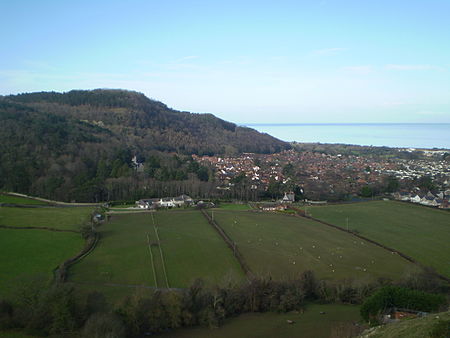Gwrych Castle (Welsh: Castell Gwrych pronounced [ˌkastɛɬ ˈɡwrɨːχ]) is a Grade I listed country house near Abergele in Conwy County Borough, Wales. On an ancient site, the current building was created by Lloyd Hesketh Bamford-Hesketh and his descendants over much of the 19th and early 20th centuries. The castle and its 236-acre estate are now owned by a charity, the Gwrych Castle Preservation Trust.
The family had owned land in the area of Abergele since at least the 16th century and claimed much older descent. In the very early 19th century Lloyd Hesketh Bamford-Hesketh determined to replace the existing house with a much larger building. Designs were prepared by Charles Busby and exhibited in 1815. Busby was subsequently sacked and Thomas Rickman engaged, while Bamford-Hesketh's ambitions grew from a Regency style country house into an enormous Gothic Revival castle. The foundation stone was laid in 1819. Bamford-Hesketh's heirs continued his building and at various times C. E. Elcock and Detmar Blow worked at the castle until it achieved its final, immense, extent. In the later Victorian and Edwardian eras the castle was run as a full-scale country house, receiving visits from Queen Victoria and Edward, Prince of Wales.
The presiding spirit was Winifred Bamford-Hesketh, Lloyd Bamford Hesketh's granddaughter, his sole heir, and Countess of Dundonald following her wedding to Douglas Cochrane in 1878. The marriage was not a success, and the countess pursued her interests at Gwrych and in London, while the earl served in Canada and as a courtier to Edward VII and George V. On her death in 1924, the countess left the castle, of which she had retained ownership, to George V, in the hope that it would become the official Welsh residence of the Prince of Wales but the gift was declined. It was subsequently re-purchased by her husband, but the family never returned to live there.
During World War II Gwrych was home to 200 Jewish children brought to Britain under the Kindertransport programme. At the war's end, the Dundonalds sold the castle. For the next forty years it operated as a tourist attraction and as a hospitality venue, but finally closed to the public in 1987. The next decades were disastrous for the structure; failed plans for development saw the castle asset-stripped of much of its fabric and furnishings, including the lead roofs, and by the 21st century it was a ruined shell. In 2018 the castle, and some 200 acres were sold to the Gwrych Castle Preservation Trust. The trust had been established by the author, Mark Baker, who had witnessed the castle's destruction as a child and had determined on its rescue. Since 2018, the trust has worked to stabilise and restore the castle. In 2020-2021 the castle received publicity and funding when it was used for the filming of I'm a Celebrity...Get Me Out of Here!.










